When cycling, the last thing you want is to feel bogged down by sweat or heat. That’s where breathable fabrics come into play. These materials help keep you cool, dry, and comfortable, regardless of how tough the ride gets. But how do they work? And why are they so vital for cyclists? Keep reading to learn more!
Breathable Fabrics
Breathability is essential for comfort and performance in cycling jerseys. The right fabric can feel like a refreshing breeze on your skin. It helps regulate your body temperature, wick away sweat, and maintain airflow as you ride. The fabric works with you, making each pedal stroke smoother and easier. Here are some fabrics that cycling jerseys use to keep you cool, dry, and ready to perform your best.
Polyester and Nylon Blends
Polyester and nylon blends excel at moisture removal. These fabrics contain small channels that pull moisture away from the skin, allowing it to evaporate quickly. This keeps riders cool and dry, even during intense rides.
Moisture Management
Fabrics such as polyester and nylon effectively manage moisture by drawing sweat away from the skin and transferring it to the outer layer, where it evaporates more easily. This moisture-wicking ability is crucial for staying dry and comfortable on long rides or in hot weather.
Quick-Drying Technology
Quick-drying materials facilitate rapid evaporation of sweat and moisture. This feature is especially beneficial during long rides or sudden rain showers, ensuring riders remain comfortable and dry.
Strategic Ventilation Panels
Many jerseys incorporate mesh inserts or ventilation panels in areas that tend to sweat the most, like the underarms, back, or sides. These panels enhance airflow, allowing cool air in and hot air out, helping to keep the rider cool.
Mesh Fabrics
Jerseys made with mesh fabrics provide excellent breathability, making them ideal for hot and humid weather. However, mesh does not offer UV protection, so riders should apply sunscreen when wearing mesh jerseys.
Merino Wool
Merino wool is another breathable fabric often used in cycling jerseys. It absorbs and releases moisture more effectively than synthetic fabrics. Merino can hold up to twice as much moisture as cotton and 30 times more than polyester, helping maintain a comfortable temperature and balance humidity between the skin and fabric.
Temperature Regulation
Merino wool helps regulate body temperature, keeping cyclists comfortable in both hot and cool conditions. This makes it ideal for varying climates.
Combination of Fabrics
Some cycling jerseys combine different fabrics to enhance breathability and moisture management. For instance, blending polyester with elastane creates a fabric that is both moisture-wicking and stretchy, offering improved comfort and durability.
High-Quality Fabric Producers
Italian manufacturers like MITI and Carvico are known for producing high-quality fabrics that provide excellent breathability, moisture management, and durability for cycling jerseys.
Snug Fit and Functional Design
Cycling jerseys are typically designed with a snug, non-restrictive fit to facilitate moisture transfer and enhance breathability. Features like full-length zippers and longer back panels also improve airflow and help regulate body temperature, contributing to comfort and performance during rides.
Moisture Management
Cycling jerseys prioritize moisture management as a primary feature. They utilize materials like polyester or nylon blends, which are breathable and wick moisture away. These fabrics have small channels that draw moisture from your skin and promote evaporation, keeping you cool and dry.
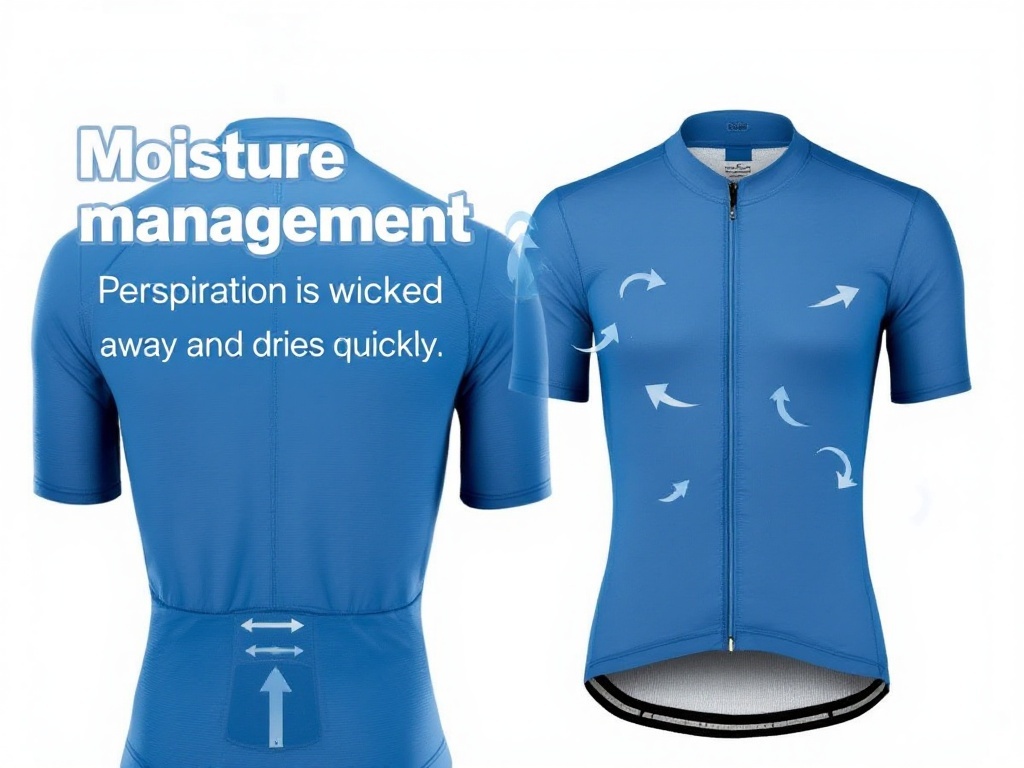
Efficient Sweat Transfer
When cycling, your body heats up, and you sweat. The jersey’s moisture-wicking properties pull sweat from your skin to the outer fabric, where it evaporates quickly. This keeps you dry, even during intense rides, preventing discomfort from a soaked, clingy garment.
Quick-Drying Technology
A significant advantage of cycling jerseys is their quick-drying capability. The materials are designed to promote fast evaporation, so moisture from sweat or rain dries quickly. This feature is particularly helpful on long rides or when the weather changes unexpectedly.
Ventilation and Airflow
Many cycling jerseys feature ventilation panels or mesh inserts in areas like the underarms, back, or sides to enhance moisture control. These vents facilitate airflow around your body, allowing cool air to enter and hot air to escape. Increased airflow accelerates sweat evaporation and helps regulate body temperature.
Layering Capability
Cycling jerseys are designed for layering. Even when worn under other clothing, their moisture-wicking properties remain effective, keeping you dry and comfortable regardless of weather changes.
Quick-Drying Technology
Quick-drying technology is vital in cycling jerseys. It aids in moisture absorption and rapid release, keeping riders comfortable during intense activity.
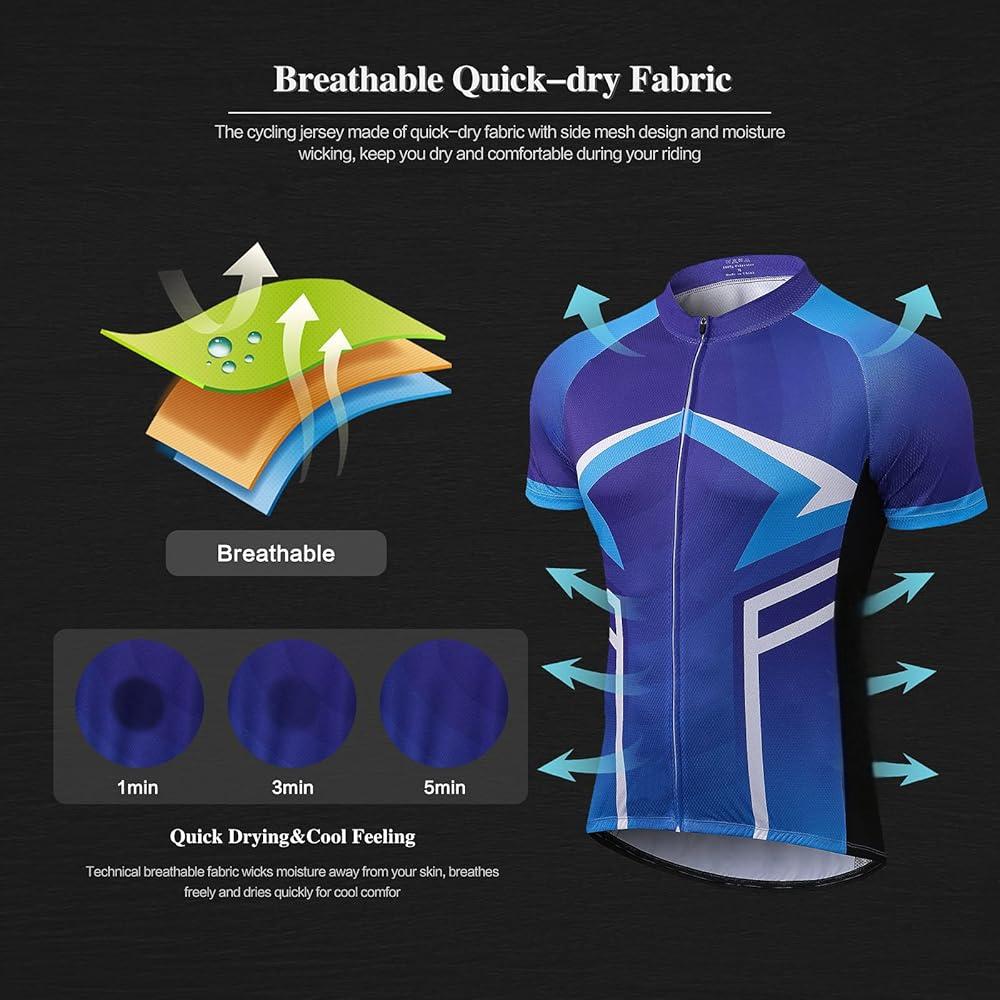
Moisture-Wicking Properties
Cycling jerseys are typically made from synthetic materials like polyester or nylon blends. These fabrics feature small channels that draw moisture away from the skin, transporting sweat to the surface for evaporation, keeping the rider dry and cool.
Rapid Evaporation
High-performance jersey fabrics are engineered to dry quickly. This feature is particularly beneficial on long rides or in unpredictable weather, such as sudden rain. The fabric’s quick-drying ability ensures comfort throughout the ride.
High-Performance Materials
Many cycling jerseys utilize materials that not only wick moisture but also drain sweat efficiently. These fabrics often incorporate special coatings or weaving techniques to expedite drying and keep your skin dry during extended exercise.
Ventilation and Airflow
Cycling jerseys also include ventilation panels or mesh inserts strategically placed in high-sweat areas, like under the arms, back, or sides. This increased airflow helps expel hot air and speeds up sweat evaporation.
Innovative Technologies
Modern jerseys feature advanced technologies, such as nanotechnology or phase-change materials, to enhance moisture absorption and drying speed. The fabric reacts to changes in body temperature, helping to regulate heat and maintain comfort in various conditions.
Design Features
The design of cycling jerseys emphasizes breathability and quick-drying. Features like full-length zippers and specific cuts maximize airflow, allowing riders to adjust ventilation as needed.
Maintenance Tips
To ensure long-lasting quick-drying performance, follow the manufacturer’s care instructions. Use the appropriate detergent and avoid bleach or fabric softeners to preserve the jersey’s moisture-wicking and breathability.
Ventilation and Airflow
Good ventilation is crucial for cycling jerseys to keep riders cool, comfortable, and dry. Well-designed jerseys incorporate features that improve airflow and manage moisture during rides.
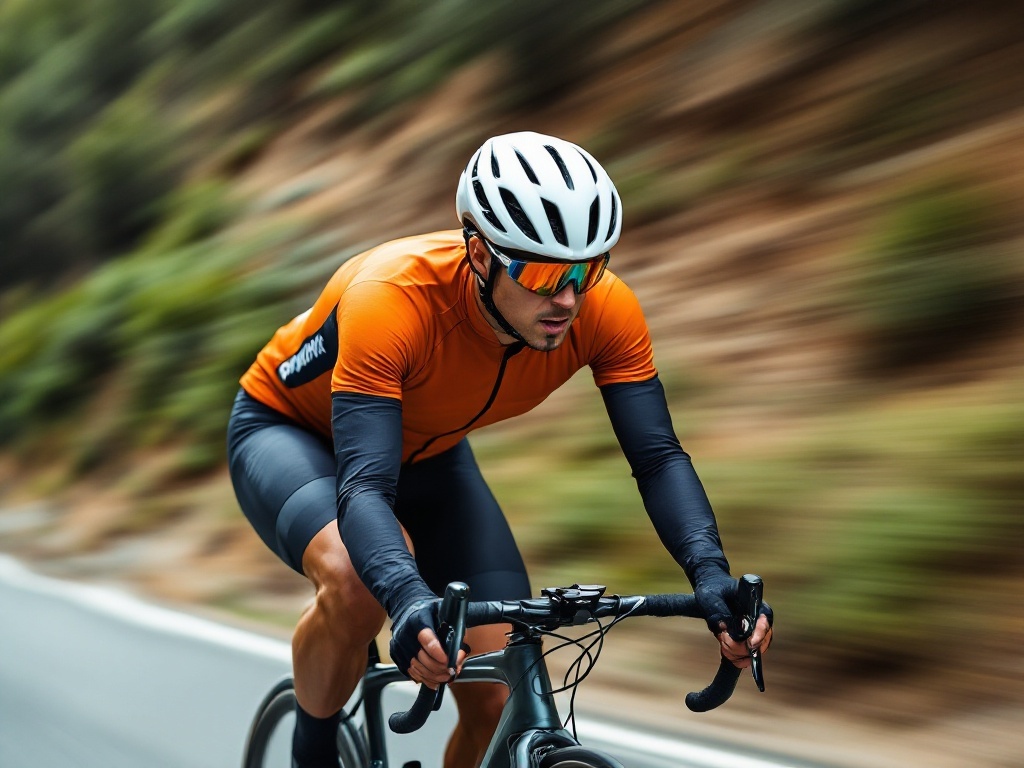
Strategic Ventilation Panels
Cycling jerseys often include ventilation panels located in areas that sweat the most, such as the underarms, back, and sides. These panels allow fresh air to flow in and hot air to escape, enhancing breathability during tough rides.
Mesh Inserts
Mesh inserts also improve airflow. Typically found on the chest, back, and arms, they allow air to move freely through the fabric, keeping cyclists cooler for longer, especially in areas where sweat accumulates.
Vents and Zippers
Some jerseys feature adjustable vents or zippers, often located on the chest or back. These features enable cyclists to control airflow based on weather conditions or effort levels. On hot days or during intense rides, these adjustments can provide instant relief and increased comfort.
Airflow Through Design
Cycling jerseys are designed with cuts or openings that optimize airflow. Areas like the legs and cuffs are thoughtfully shaped to avoid obstructing airflow, even during high-performance riding. This ensures cyclists remain cool throughout their ride.
Enhanced Sweat Evaporation
Improved airflow cools the body and aids in sweat evaporation. Jerseys made with quick-drying fabrics pull moisture away from the body, accelerating evaporation. This system keeps riders dry while maintaining an optimal body temperature, even during challenging rides.
High-Tech Materials
Modern cycling jerseys are crafted from high-tech fabrics like polyester, nylon, or specialized synthetic fibers. These materials allow air to pass through while enhancing moisture-wicking capabilities, ensuring the jersey remains breathable even in hot and humid conditions.
Adaptability to Conditions
Cycling jerseys are designed to handle various riding conditions. Whether you’re cycling in heat or humidity, these jerseys maintain breathability and effectively wick moisture, managing sweat and enhancing airflow to keep cyclists comfortable in diverse weather.
Functional Design for Riding Position
The design of a cycling jersey considers the rider’s position. For example, a longer back panel ensures the jersey stays in place, even in an aerodynamic posture. This design feature preserves airflow and ventilation, keeping the rider cool and comfortable.
Functional Design
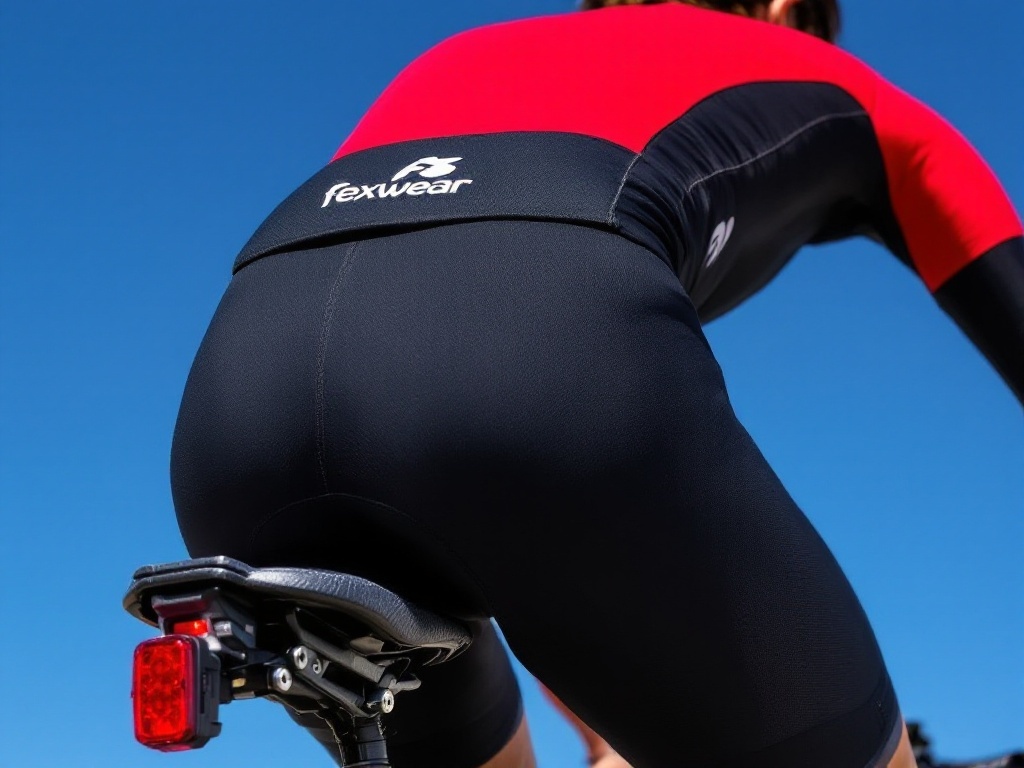
The design of cycling jerseys is crucial for breathability and overall performance. Here are some key elements that enhance the design:
Advanced Materials for Breathability
Cycling jerseys utilize synthetic materials like polyester, nylon, or specialized fibers. These fabrics feature small channels that move moisture away from the skin, facilitating quick evaporation. This keeps the rider dry and comfortable.
Strategic Ventilation Panels
To boost airflow, cycling jerseys frequently incorporate ventilation panels or mesh inserts in high-sweat areas like the underarms, back, or sides. These mesh zones allow cool air in while pushing hot air out, enhancing comfort.
Snug Fit for Efficient Moisture Transfer
Cycling jerseys are typically designed to fit snugly without restricting movement. This design facilitates effective moisture transfer and prevents the jersey from riding up. Many jerseys also feature a longer back panel for added coverage while cycling.
Adjustable Ventilation Options
Many jerseys come with vents or zippers on the chest or back to adjust airflow as needed. These openings are particularly beneficial during intense rides or on warmer days, allowing cyclists to regulate their body temperature.
Breathable and Adaptive Layering
Cycling jerseys are often part of a layering system. In hot weather, the jersey can be worn alone, while in cooler conditions, a base layer can be added without sacrificing breathability.
Aerodynamic and Moisture-Wicking Design
A tight-fitting design reduces air resistance, potentially improving speed and endurance. In fact, minimizing air resistance around the arms can enhance performance by up to 8%. The moisture-wicking fabric also keeps the rider dry and comfortable throughout the ride.
Innovative Fabric Treatments and Technologies
Modern cycling jerseys often feature special coatings or weaving methods to improve moisture-wicking abilities. Some jerseys also incorporate technologies like nanotechnology, phase-change materials, or thermoregulation to enhance breathability and ensure rider comfort in varying conditions.
Impact on Comfort and Performance
Breathability in cycling jerseys is crucial for both comfort and performance during rides.
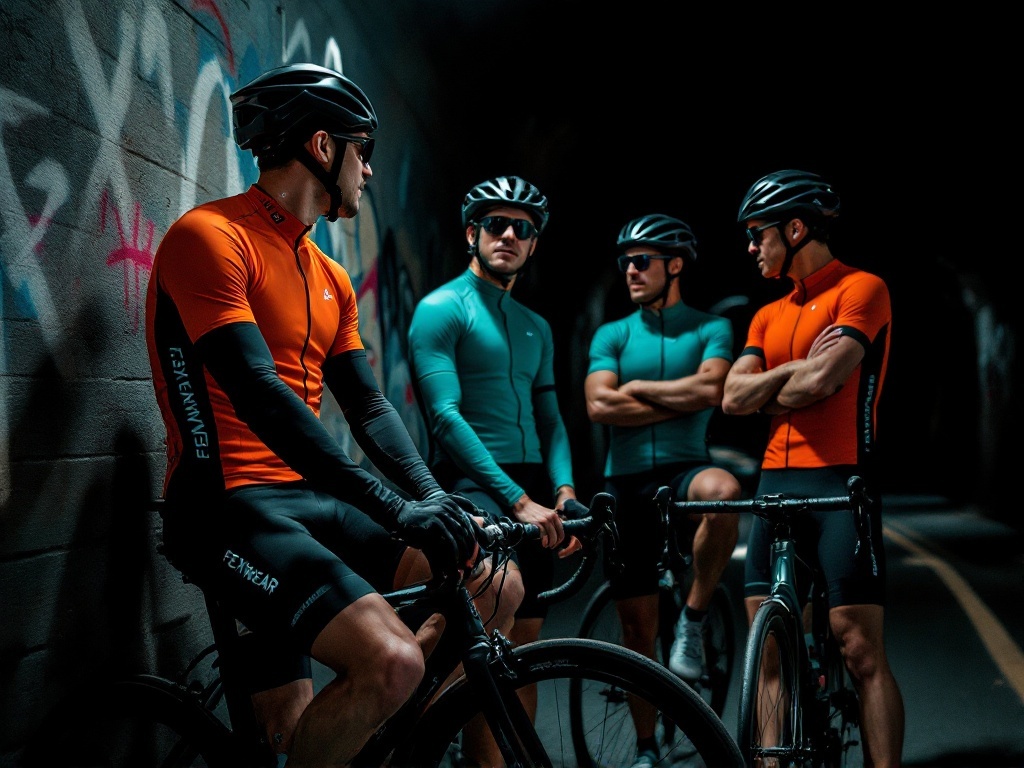
Moisture Management
Breathable fabrics wick moisture away from the skin, facilitating quick evaporation. This keeps the cyclist dry and helps prevent discomfort from damp clothing.
Ventilation and Airflow
Jerseys often feature mesh inserts or ventilation panels in areas like the underarms and back. These features allow airflow, helping regulate body temperature and release excess heat, especially on hot rides.
Quick-Drying Technology
Materials designed for rapid moisture evaporation ensure that sweat does not linger on the skin. This quick-drying technology is vital for comfort on long rides or during sudden rain showers.
Maintaining Energy Levels
By staying cool and dry, breathable cycling jerseys help cyclists conserve energy. This improves endurance and performance, allowing the rider to focus on the road without worrying about sweat or discomfort.
Aerodynamics
Breathable fabrics also contribute to aerodynamics. For example, the Sportful Bomber jersey’s raglan sleeves and micro mesh reduce air resistance, enhancing performance while keeping the rider comfortable. The snug fit aids aerodynamics without limiting movement.
Layering Flexibility
Breathable jerseys are often part of a layering system, enabling cyclists to adapt to changing weather conditions. Whether it’s a chilly morning or a sweltering afternoon, breathable fabrics maintain comfort and performance.
Fabric Choice and Fit
Synthetic materials like polyester and nylon are favored for their breathability and moisture-wicking properties. These fabrics feature small channels that effectively pull moisture away from the skin. A snug, non-restrictive fit ensures efficient moisture transfer while preventing the jersey from riding up. Features like longer back panels and full-length zippers enhance airflow when needed.
Safety and Visibility
Breathability in cycling jerseys goes beyond comfort; it is crucial for enhancing safety and visibility, especially in low-light conditions.
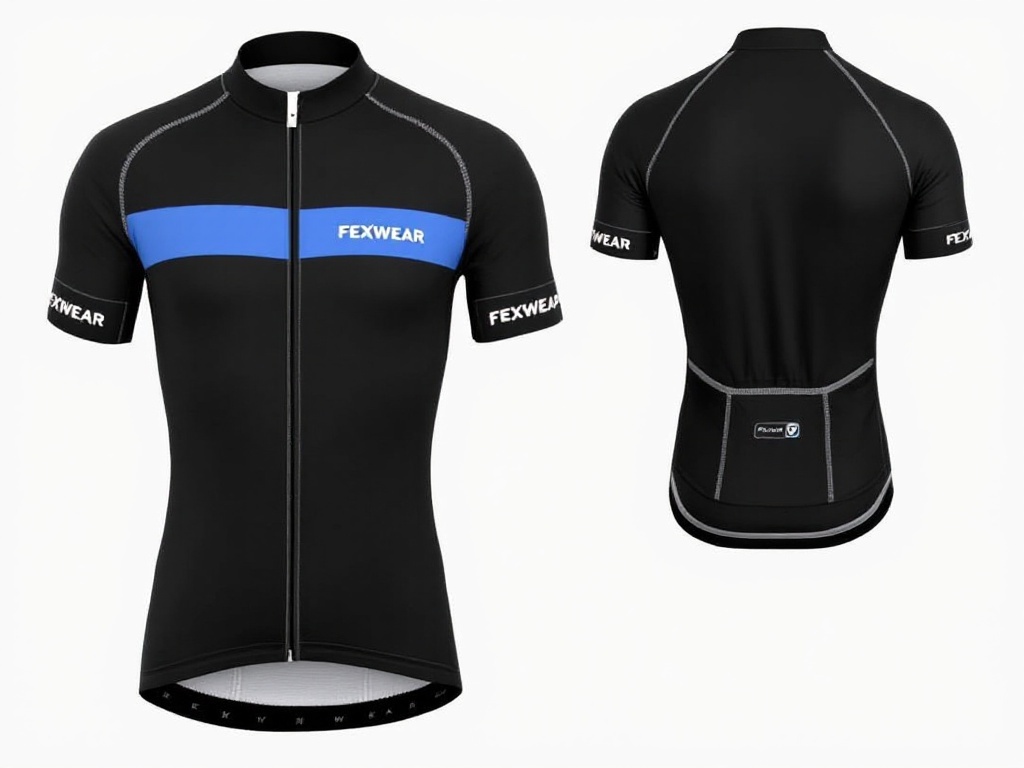
Breathable Fabrics and Comfort
Cycling jerseys utilize breathable fabrics such as polyester or nylon blends. These materials feature small channels that quickly move moisture away from the skin, keeping the rider dry and comfortable. A comfortable cyclist can focus better on their surroundings, improving safety.
Reflective Elements for Low-Light Visibility
Many cycling jerseys incorporate reflective materials, such as 3M™ Scotchlite Reflective. These elements are strategically placed to enhance visibility in low-light settings without compromising the fabric’s breathability, ensuring cyclists remain visible to drivers in the early morning or evening hours.
Ventilation and Safety
In addition to breathability, jerseys often include ventilation panels or mesh inserts. These features promote airflow, regulate body temperature, and accelerate sweat evaporation. A cooler, drier cyclist is more alert and aware of their surroundings, further enhancing safety.
Layering for Adaptability and Visibility
Breathable jerseys work well as part of a layering system, providing flexibility for various weather conditions. By adjusting layers, cyclists can stay comfortable and visible, regardless of the situation.
By combining breathable fabrics with reflective elements and smart design, cycling jerseys deliver significant safety benefits. They enhance comfort and visibility, particularly in low-light environments.
Aerodynamic Efficiency
Cycling jerseys designed for aerodynamic efficiency improve performance while prioritizing breathability for comfort during rides. Advanced fabrics and thoughtful design help maintain airflow and manage moisture, keeping you cool at high speeds.

Moisture-Wicking and Quick-Drying Technologies
Cycling jerseys utilize moisture-wicking materials to draw sweat away from the skin and accelerate evaporation. This prevents overheating and ensures you stay dry and comfortable during your ride. Polyester and nylon blends are commonly used for this purpose. Quick-drying fabrics swiftly eliminate sweat, guaranteeing comfort during intense rides.
Strategic Ventilation for Better Airflow
Ventilation panels or mesh inserts in areas like the back and underarms allow cool air to flow while expelling hot air. This enhances breathability and keeps you cooler, especially during intense cycling sessions.
Fit and Design for Reduced Drag
The aerodynamic fit of these jerseys minimizes air resistance by reducing fabric wrinkles and flaps. This allows for smoother pedal strokes and less drag, enabling cyclists to maintain higher speeds with less effort.
These features create a balanced combination of aerodynamic efficiency and breathability, optimizing both performance and comfort.
Summary
Choosing the right cycling jersey is akin to finding a great partner for your ride. It supports you throughout, with breathable fabric keeping you cool and moisture-wicking technology ensuring you stay dry, no matter how tough the ride gets. With each pedal, the jersey moves with you, like a second skin, allowing you to focus on the road ahead.
Whether you’re enjoying a leisurely ride or racing hard, the right gear makes a significant difference. It transforms discomfort into effortless speed.
For more information and to explore our selection, visit fexwear.com.
